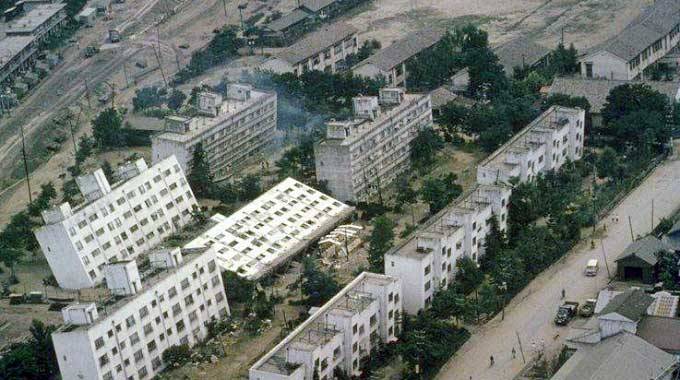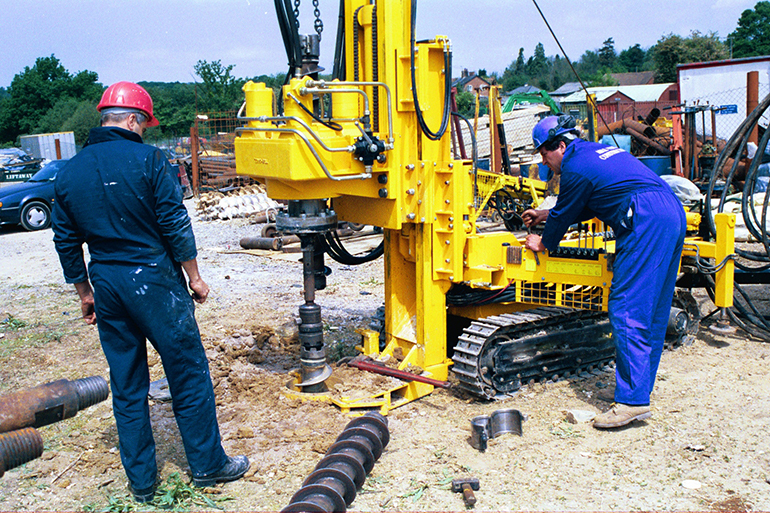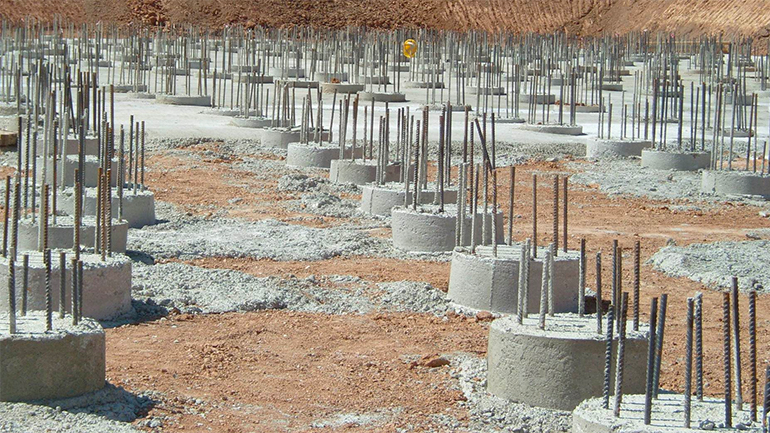Soıl Lıquefactıon In Earthquakes — Its Effects On Structures And How To Avoıd It

Abstract
Cases of structure failure caused by soil liquefaction during earthquakes are reviewed. The mechanism of soil liquefaction is summarized. Methods to identify soil liquefaction are introduced and mathematical models to simulate soil liquefaction are presented. Based on the historical facts and the nature of soil liquefaction, ways by which to reduce soil liquefaction potential during earthquakes are suggested, with the emphasis on the structural design aspect. Key Words: Soil Liquefaction, Earthquake, Structural Failure
Introduction
During earthquakes, soil failures, especially soil liquefaction, can cause devastating effects on structures, such as land-sliding, lateral spreading, large ground settlement and so on. This phenomenon has been observed for many years. In fact, many of the structural failures in ancient earthquakes can be associated with soil liquefaction based on the knowledge we process today. But this phenomenon was not brought to the attention of engineers until after the Niigata earthquake and the Alaska earthquake, both of which occurred in 1964 and demonstrated lots of typical soil liquefaction effects. Since then, careful observations and in-depth research on this phenomenon have been carried out by engineers and scientists all over the world. The mechanism of this phenomenon has been studied and principles drawn from these studies have been applied to practical engineering designs and construction. However, due to the complex nature of soil and liquefaction, this phenomenon is far from thoroughly understood.
Soil Liquefaction in Some Major Earthquakes
All strong earthquakes are accompanied by the phenomena of soil liquefaction of some kind. Liquefaction can cause the failure of structures of any form in many modes. Some typical cases of structure failure caused by soil liquefaction in some major earthquakes are summarized below.

1. The Niigata Earthquake
Fig. 1 shows overturned buildings in the Niigata Earthquake, which occurred on June 20, 1964 in Japan with a Richter magnitude of 7.7. The buildings in the picture remained relatively intact but rotated as whole structures because of the land-sliding under their foundations. The land-sliding was determined to have been caused by soil liquefaction.

2. The Alaska Earthquake
The Alaska Earthquake, which occurred on March 27, 1964 in the Gulf of Alaska, had a Richter magnitude of 8.5. It was one of the largest
earthquakes in the 20th century and caused many structural failures due to soil liquefaction. It is earthquake, together with the Niigata Earthquake that called the attention of engineers to the phenomenon of soil liquefaction in earthquakes. Fig. 2 shows the failure of a road embankment caused by soil liquefaction. The failure of the roadbed caused the embankment to spread to the two sides of the road, thereby tore the embankment apart.

3. The Loma Prieta Earthquake
The October 17,1989 Loma Prieta Earthquake had a Richter magnitude of 7.1. It was also not exempted from significant structure failures caused by soil liquefaction. Fig. 3 shows a sand boil at the Oakland International Airport caused by soil liquefaction in the earthquake.
4. The Kobe Earthquake

Liquefaction caused by strong dynamic ground motion during the Kobe earthquake (7.2, Richter) also contributed greatly to the structure failure, especially the failure of the bridges and viaducts on the Hanshin Expressway. Fig. 4 shows the Nishinomiya Bridge with one span of its deck fallen to the ground. The supports of the bridge were not damaged, but large ground deformation occurred. Soil liquefaction played a key role in the failure of this bridge.
5. The Izmit Earthquake
The Izmit earthquake is a more recent large earthquake, which hit Turkey on August 17, 1999, with a Richter magnitude of 7.4. This earthquake caused many deaths because of residential building failure. One common failure type of buildings is caused by soil-liquefaction-induced loss of bearing strength beneath shallow mat foundations. Fig. 5 shows one typical example of these phenomena.
6. The Taiwan Earthquake
One other effect of soil liquefaction large ground settlement, can be found in the September 21, 1999 Taiwan Earthquake (7.6, Richter). Fig. 6 shows the damage of the Taichung Harbor caused by soil liquefaction. Large ground settlement can be seen in the picture as well as the water burst out from the deeper soil layer can be easily discerned.
Mechanism of Soil Liquefaction
Given the examples above, it is necessary to understand the mechanism of soil liquefaction, where it occurs and why it occurs so often in earthquakes.

Liquefaction of soil is a process by which sediments below the water table temporarily lose strength and behave more as a viscous liquid than as a solid3. Liquefaction occurs in saturated soils, especially clay-free sand and silts. The water in the soil exerts pressure upon the soil particles. If this pressure is low enough, the soil stays stable. But once the water pressure exceeds a certain level, it forces the soil particles to move relative to each other, thus causing the strength of the soil to decrease and failure of the soil follows. During earthquakes, when the shear wave passes through saturated soil layers, it causes the granular soil structure to deform and the weak part of the soil begins to collapse. The collapsed soil fills the lower layer and forces the pore water pressure in this layer to increase. If the water pressure cannot be ready released, it will continue to build up until it can sustain the total weight of the soil layer above, thus the upper layer soil are ready to move and behave as a viscous liquid. It then is said that soil liquefaction has occurred. Fig 7 shows the shear deformation of soil caused by dynamic earthquake load.

Although soil liquefaction is usually followed by significant structural failures, it does not happen everywhere. There are some places that are more susceptible to soil liquefaction. Generally, the more loose the soil and the higher the underground water level, the more likely liquefaction is to occur at this site during earthquakes. The degree of ground deformation caused by soil liquefaction is always depended on the age, density, and depth of the soil. The slope of the ground, as well as the characteristic of the structure sitting upon the ground, will also affect the soil deformation caused by liquefaction.
Soil liquefaction is a very complex phenomenon, but it generally can be put into two major categories, that is flow liquefaction and cyclic mobility.
Flow liquefaction occurs in large soil areas where the strength of the liquefied soil is extremely low and the ground has a rather deep slope. When the static equilibrium is destroyed by dynamic earthquake load or sometimes even a small load, the huge soil body can “flow” as a whole and in some instances travel a very long distance (even of tens of miles) with very high velocity. Because of this characteristic, this type of soil liquefaction is always the most disastrous. Fig. 8 shows the mechanism of this type of soil liquefaction and the damages to the buildings shown in fig. 1 and fig. 5 are typical damages caused by flow liquefaction.
Cyclic mobility is triggered by cyclic loading at places where the shear stress of the soil is lower than the soil strength and the ground slope is moderate. During earthquakes, cyclic mobility of the soil increases steadily with the dynamic load, and finally triggers the soil to fail. One common result of cyclic mobility is lateral spreading, which occurs when the subsiding soil cannot bear the surface layer any longer. Thus the gravitational forces, together with the inertial forces built up by the dynamic earthquake load cause the surface soil layer to fail. Fig. 2 and 3 show cases of soil liquefaction caused by cyclic mobility.
Identification of Soil Liquefaction
Most soil liquefaction has devastating effects, which can be very easily identified. But there are cases where liquefaction has occurred in some earthquakes without structure failure. It is necessary to identify these cases and reinforce the soil below the structure to avoid possible future failure.
Several techniques have been developed to do this job. One is to place two accelerometers at the site, with one at some depth in the soil and one in the surface layer. If the ground acceleration recorded at the surface level is significantly smaller than that recorded by the one underneath, and the upper layer ground exhibits apparently longer period of motion, it can be determined that soil liquefaction has occurred to some extent at this site. This vtechnology has been used at the Higashi-Kobe Bridge which is near the epicenter of the 1995 Kobe earthquake. During the earthquake, the bridge site underwent very strong ground motion. Fig. 9 shows the time histories of the earthquake recorded by two accelerometers, one on the ground level (G2) and the other in a depth of 34m. Compare the two time histories, it can be seen very clearly that the ground acceleration at the surface layer is much smaller than that of the depth of 34m. And the period of the ground acceleration is apparently much longer at the surface. This suggests strongly that soil liquefaction has occurred to a certain extent at this site during the earthquake, although the earthquake produced no severe damage to the bridge.

Simulation of Soil Liquefaction in Earthquake Design
Because of its devastating effects on structures, it is very important to include liquefaction as a consideration in earthquake design for soil sites that are susceptible to this phenomenon so that measures can be taken to reduce the potential hazard.
Many mathematical models have been developed based on different soil properties, different structure types and foundations to simulate soil liquefaction induced by dynamic load. In finite element modeling, two kinds of models are generally adopted. One uses soil springs to simulate the soil around the structure foundation. Different stiffness of the springs is adopted during different stages of the soil behavior during earthquakes. In this model the super-structure is simplified as concentrated masses that are connected by stiff rod elements. The other model uses large scale finite element simulation, in which the soil, the foundation and the super-structure are all simulated using different types of finite elements reflecting their relative properties. In particular, special soil elements are used to simulate the soil-foundation boundary and parameters of the soil elements and the boundary elements are adjusted according to different stages of soil deformation. The second model has some advantages over the first model in that it takes into consideration the effects of soil-structure interaction. The soil no longer acts alone, which is closer to reality. Furthermore, it effectively distinguishes the soil closer to the foundation from the soil farther away from it. It has been discovered that the soil near the structure foundation has more complex properties and is more likely to liquefy because of the dynamic disturbance from the foundation and water pressure is more difficult to dissipate in this region. The difficult part of the soil liquefaction modeling is soil parameter identification. There has been considerable work done on this subject and more actively underway.
Methodologies to Reduce Soil Liquefaction Potential
Soil liquefaction does occur and it is rather hard to predict it. Yet it is the engineer s responsibility to reduce the potential for soil liquefaction and the catastrophic results it brings to structures and. Although there is still a lot to learn about soil liquefaction, some general rules should be followed to reduce the potential of soil-liquefaction-induced structure failures. Some suggestions are summarized below.
First, avoid building structures in areas that are susceptible to soil liquefaction, which is the best policy. These areas incluide*:
1. areas known to have experienced soil liquefaction during historic earthquakes;
2. all areas of uncompacted fills containing liquefaction susceptible material which are saturated, nearly saturated, or can be expected to become
* Based on “Earthquake Basics”, Earthquake Engineering Research Institute saturated;
3. areas where sufficient existing geotechnical data and analyses indicate that the soils are potentially liquefiable;
4. areas underlain with saturated geologically young sediments (younger than 10,000 to 15,000 years old); and
5. areas that has a relatively steep ground slope.
Second, improve the soil if it is absolutely necessary to build structures in liquefaction-susceptible areas. Such approaches include soil exchanging, dynamic soil compaction, concrete grouting and installing stone or concrete column and1.
Third, structures can be built to be liquefaction resistant. Some areas may not seem liquefaction-susceptible, but the structure may be very important, examples include densely populated residential buildings, long bridges and large dams on major rivers. It is especially important to put soil liquefaction validation into the design process for these structures.
Based on the mechanism and forms of soil liquefaction and the lessons learned from past earthquakes, some suggestions can be provided as follows for structural design:
1. Provide sufficient drainage at the foundation so that water pressure in the soil will not easily build up under dynamic load.
2. Design strong foundation mats so that the structures do not fail even
though liquefaction occurs under part of their foundations. The building in
Fig. 5 experienced failure because it did not have a strong enough mat.
3. Include angled piles if pile foundations are adopted. Because, if soil faction occurs in earthquakes, the piles will sustain not only vertical load, but also lateral load.
4. Reinforce weakened soil around structures after earthquakes or some other dynamic load; repair damaged foundations.
Conclusions:
Soil liquefaction is a common phenomenon during earthquakes. Its effects on structures are devastating and it occurs in many forms. The mechanism of soil liquefaction is very complicated due to the nature of soil, which renders it difficult to fully understand. Because of the consequences it can bring to structures, soil liquefaction should be an important factor considered in earthquake design, especially for important structures. Research has been performaed to identify and model the phenomenon of soil liquefaction so as to provide references for earthquake design. To reduce the potential for structure failures caused by soil liquefaction, some general rules have to be followed.
Recommendations
Soil is a material that has the one of the most diverse forms and most complex properties. Much research has been performed to study this material, both computational and experimental. But there seems little work done to understand the properties of the part of soil at the soil-structure interface, which has different properties as compared to the ordinary soil and could play a decisive role in the behavior of both the soil and the structure during such severe loads as earthquake, including soil liquefaction. This may be a future focus of study.
One other possible field of study concerning soil liquefaction is to combine this phenomenon with the other commonly observed phenomena during earthquakes, such as soil-structure separation and soil softening. There has been some work done in this field. A critical part of this area of research is soil parameter identification, which has always been a difficulty.
References:
1. Soil Liquefaction Web site, University of Washington,
www. ce.washington.edu/~liquefaction/html/main. html
2. “The Izmit (Kocaeli), Turkey Earthquake of August 17, 1999“, EERI Special Earthquake Report, Oct 1999, www.eeri.org/Reconn/Turkey0899/Turkey0899.html
3. “The Chi-Chi, Taiwan Earthquake of September 21, 1999“, EERI Special
Earthquake Report, Oct 1999, www.eeri.org/Reconn/Turkey0899/Turkey0899.html
4.”Earthquake Basics–—Liquefaction, What it is and what to do about it”, Earthquake Engineering Research Institute, www.eeri.org/eq Basics/liq/LIQUEFAC.html
5. ” Response Analysis of the Higashid-kobeBridge and Surrounding Soil in the 1995 Hyogokendnanbu Earthquake”, Todor Ganevi, Fumio Yamazaki, Hiroshi Ishizak and Masahiko Kitazawa, “Earthquake Engineering and Engineering Dynamics”, 557- 576,1998












